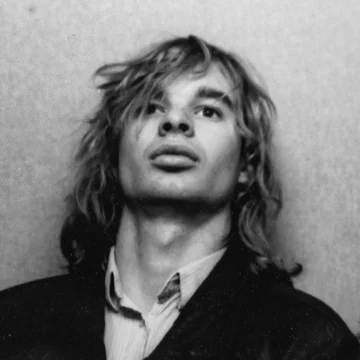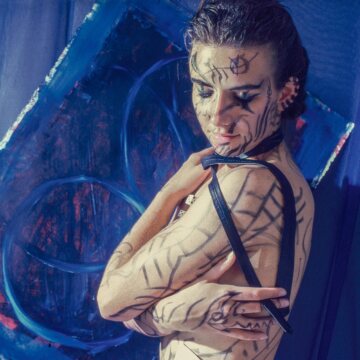Education and Influences
Knight saw photographic equipment as merely a means to an end. His interest lay in preparing the scene in front of the camera.

Aaron Knight attended a boarding school in Denton, Texas that had one full-time and one part-time art teacher. Neither oil painting nor photography classes were offered at the small high school. An adolescent fascination with surrealists like Salvador Dalí and Jerry Uelsmann inspired him to experiment with painting and photography. Yet he had not considered undertaking nude photography education. As a graduation gift, his mother chose a large set of oil paints from Holland. He also requested and received a used Nikon SLR film camera.
Knight studied art at Fort Lewis College in Durango, Colorado. His art degree included the traditional disciplines of oil painting and drawing. This foundation would influence his compositional approach to photography, in which he weighs design elements independently from the medium when constructing an image. He composes photographs in a similar fashion to how he would complete an oil painting—it was never his goal to capture moments of reality.
Knight took photography classes but didn’t see results until he practiced what his parents had taught him: You get no more out of life than you put in. He took his camera everywhere, attaching it to his belt so he could scale fences or climb onto rooftops after midnight for time-lapse exposures. On occasion, his activities attracted the attention of the police. However, after a short explanation, he was always released without arrest.
Fascinated by people, he photographed both male and female students. For most photography assignments, he found ways to include a human subject.
He enrolled in extra course hours to study advanced photographic techniques, painting, printmaking, and art history. He trained in both traditional and archaic processes such as view cameras, medium format, darkroom chemistry, and color transparency. He hand-produced Ilfochrome as well as selenium-toned, black-and-white, fiber-based photographs and experimented with liquid emulsions to layer photographic imagery with painting and drawing.
A theater design class expanded his lighting and set-building skills. Large oil paintings became backdrops for photoshoots. He learned to airbrush, inspired by Olivia De Berardinis. Combined with sculpture classes, these skills helped him create photo sets. He would photograph other students under colored lights after drawing labyrinths of lines on their bodies or adhering objects to them.
On a college trip to Italy, he watched another visitor take only two photos of Michelangelo’s David after spending several minutes selecting a separate lens for each. This was one of many examples that demonstrated an emphasis on how tools could threaten creativity. He learned that technique had little utility until he had a compelling concept.
Nude photography education
Knight's nude photography education included luminaries such as Ruth Bernhard and Edward Weston, and was especially intrigued by Bernhard’s subtle Nude in the Box. Robert Mapplethorpe’s nudes of bodybuilder Lisa Lyon also captivated him. Working with graphite, he attempted to blend the two approaches. Despite the fame that nude photography rebels like Helmut Newton and Mapplethorpe achieved in magazines and galleries, the avant-garde was in a different league than the museum-exalted nudes by Weston and Uelsmann. In light of this, Knight feared his nascent contribution would be misunderstood or dismissed. He limited his initial study of the nude to painting and drawing reference images in books and magazines.
He took every opportunity to photograph art students, theater students, and others with a creative side but almost never fully nude. His first art from live nudes was of student models in figure drawing class. Knight also worked as a model, posing for life drawing classes if no other model was available. His first nude photoshoot in college was almost by accident. He invited a female classmate to pose, and she emerged nude, making an assumption based on the norm for drawing class. He did only one other fully nude photoshoot in college, also at the request of the model.
Knight’s enduring influences are nuanced storytellers like Sandy Skoglund and Sally Mann. He admires the elaborate theatrical scenes Skoglund creates. Although she produces photographs, Skoglund’s artistry is in constructing her subject matter. This paradox of using the camera to document a fabricated reality spurred him to conceive of photographic art with a mindset comparable to directing a movie.
It wasn’t until after college that Knight sought additional nude subjects. Within a few years, he transitioned to working exclusively with the female nude.
As Knight transitioned to exclusively making nudes for art, his motivation moved away from the shock value of Mapplethorpe and the tour-de-force wizardry of Uelsmann. He now aspires to the lighting and storytelling techniques of painter Edward Hopper, the cinematic qualities of Mann, and the design mastery of Skoglund. He has also made a series of photographs prompted by Mel Ramos’s surreal pin-up nude paintings.
Knight is committed to the continual enhancement of his nude photography education. He strives to learn creative ways to communicate visually and reinvent the female nude. Knight’s artistic philosophy rejects formulaic rules, predictability, and mass appeal. To explore a genre, he believes we must contribute new ideas and meaning.
Both Knight’s mother and sister are painters, and he occasionally shares his work with them for critique and discussion. He also solicits feedback from longtime artist friends scattered across the country.

